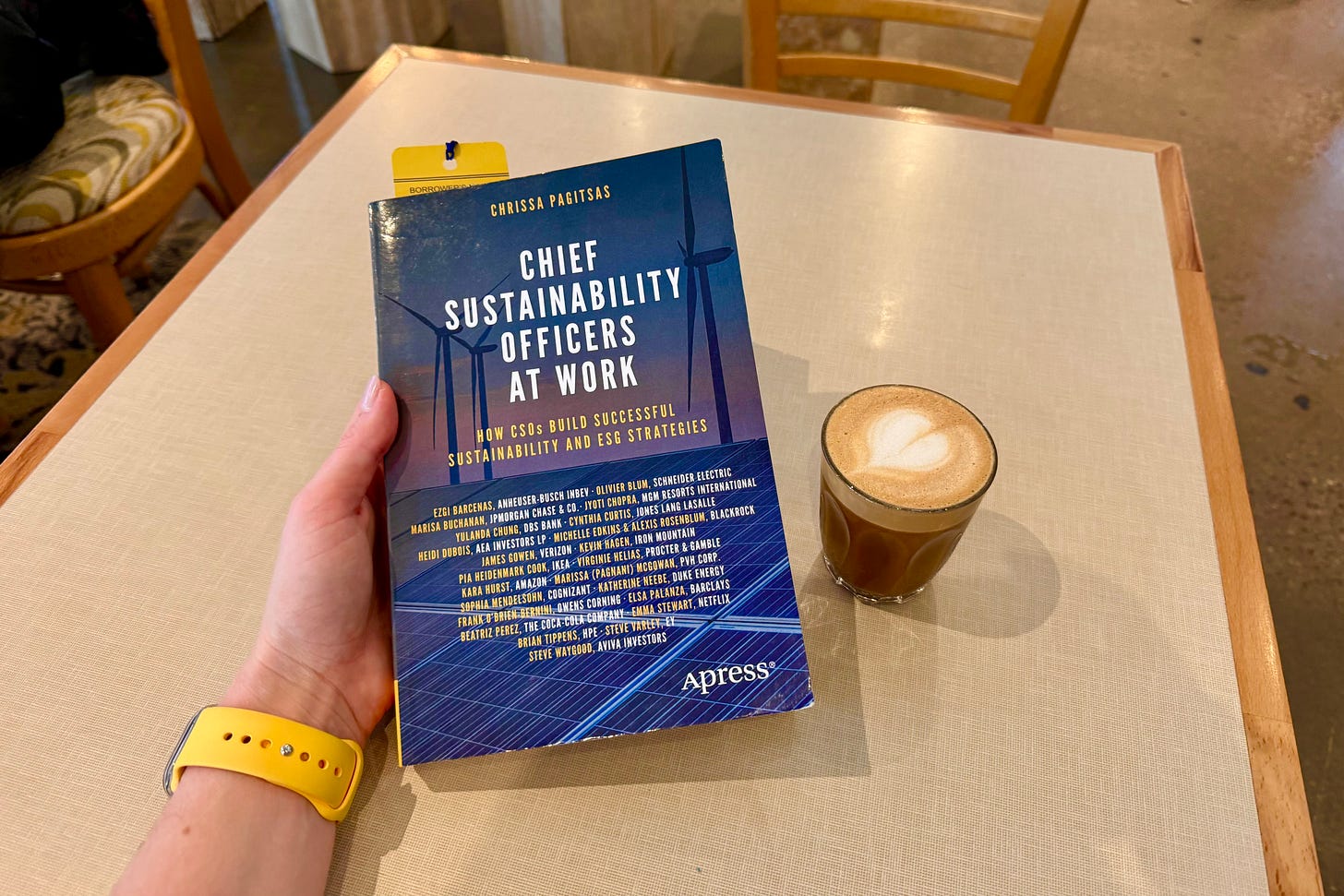TCC #45: Chief Sustainability Officers at Work
How do sustainability professionals approach one of the biggest global problems?
Recently I read Chrissa Pagitsas' Chief Sustainability Officers at Work, a collection of interviews with high-profile sustainability professionals at companies like Amazon, IKEA, Coca-Cola, and more.
This book is clearly designed for people looking to enter the field of sustainability or move up its ranks, so we're looking at a very particular subset of 'climate communications' today: communicating corporate climate action to other corporate sustainability professionals.
Unfortunately, even though it’s designed as a guide for fellow professionals, this book fell into the corporate trap.
It spends way too long in weasel territory ("we are committed to this and this and this") and nowhere near enough on the actual work. There's not enough: what does a typical day look like for you? What kinds of tasks make up the bulk of your work? What are the biggest challenges in your role specifically?
But between all the weasel words, here's what I did learn.
1 — Sustainability is still deeply connected to the marketing function.
I was surprised to see so many former marketing/comms professionals now holding high-ranking sustainability positions. This demonstrates to me that companies still see their ESG efforts as intrinsically linked with their corporate reputation.
2 — Many high-ranking sustainability professionals do not have scientific or technical backgrounds.
At the higher levels, success in sustainability may very well come down to not how well you understand the nuances of the particular science involved, but rather how well you advocate for resources, form relationships with executives, and find openings to embed sustainability throughout the entire business.
Every person interviewed had a deep understanding and knowledge of the company. In fact, many had worked at the company for years or even decades, transitioning into sustainability from within the ranks, rather than applying externally with sustainability qualifications. This demonstrates to me that boards and senior executives prefer sustainability handled by people who know the business, not the science. It’s not surprising, but it’s something to keep in mind.
3 — Sustainability cannot be effective in a silo.
Here’s Kevin Hagen from Iron Mountain talking about the disconnect that can occur when sustainability teams are not brought in to the core of the business:
“While we [the sustainability team] were promising to cut energy consumption in half, the business strategy team was promising to grow our data center business—one of the most energy-intensive industries short of mining. We were never going to LED our way out of that.”
4 — Sustainability is the “ultimate design brief.”
This is how Ezgi Barcenas, the CSO at Anheuser-Busch InBev, sees it. “Sustainability for us is about innovation,” he says. “It allows us to rethink and redesign the future of packaging, the future of agriculture, the future of logistics, etc.” I keep thinking about this — about sustainability being the ultimate design brief. Whether you’re designing products or services, working out how to deliver them in ways that don’t harm (and maybe even positively affect) people and the planet — what could be a more interesting challenge than that?
5 — Sustainability in marketing requires finding the “golden middle ground.”
Here’s Pia Heidenmark Cook, CSO at IKEA: “If you tell too little, then consumers may assume you’re hiding something, and you’re not transparent. If you tell too much, then consumers assume you’re greenwashing. So how do you find that golden middle ground where you’re credible?”
It’s a challenge for marketers, communications professionals, and brand managers everywhere. Getting your sustainability story right requires a mix of scientific, legal, and creative expertise. For marketers too, sustainability is also the ultimate creative brief.
6 — Sustainability communications must take different forms for different audiences.
Here’s Emma Stewart, Netflix’s Sustainability Officer: “Netflix’s net-zero’s target design itself is rather complex and grounded in science, so we used a combination of technical blogs, and investor-ready ESG report, and a short film, Netflix’s natural storytelling medium, to explain the arc of our reasoning.”
Here’s Pagitsas, the author, speaking in another interview: “Companies today need to create a surround sound strategy for their ESG communications, like a 360-degree stage at conferences. It’s not enough to put our an annual ESG report. You need to intersect with many stakeholders in many different formats.”
7 — A focus on compliance-based disclosure will hinder corporate climate action.
Brian Tippens of HPE warns that the world of mandated climate disclosure will infringe on companies’ ability to get out there and do good. “If we are to change the world we live in,” says Tippen, “I fear the focus on [compliance] while critically important can hinder the focus on [action].”
“Why? If we get to the point where we’ve got to get sign-off from our legal teams because these measurements will be reported in 10-Ks, we’re not going to make any bold positions.”
This idea stuck with me, in part because I think we’re already there. Legal disclaimers in ESG reports are doubling in size. Greenwashing guidelines are clamping down so hard that companies are scared to report anything other than numbers in a table. And certainly, when you think about all the ways that well-meaning sustainability initiatives can go wrong (a carbon project that turns out to be bogus, engaging a recycling partner that ends up reselling your shoes in Indonesia) — it’s no wonder that even sustainability leaders are shutting their mouths.
Here’s Olivier Blum, of Schneider Electric, on the same topic: “If your company stops at compliance reporting, there will be no progress or innovation as a company or society. This is because standardization reflects the past. It does not reflect the future. When we standardize too much of a business’s activity, it becomes a kind of tick-the-box exercise, and nobody tries to be progressive and innovate.”
Spending all your time reporting is one thing, but using reporting guidelines as benchmarks for climate ambition is one way to make sure we remain 50 years behind schedule.



